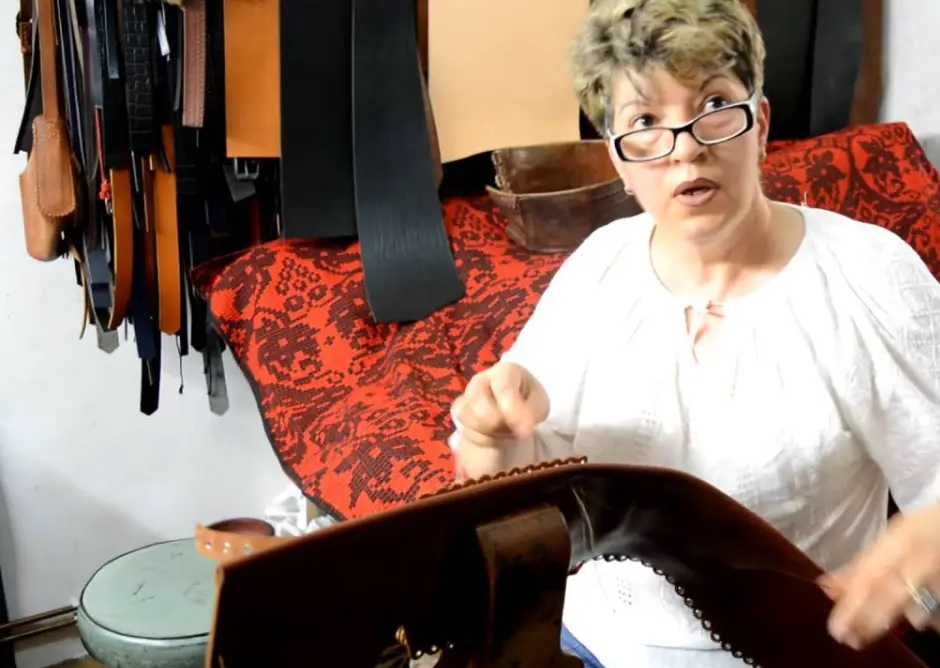
Carmen Tălmaciu, meșter pielar, practică această meserie de peste 25 ani Tălmaciu Carmen este un meșter pielar din localitatea Cugir, județul Alba, aceasta realizează produsele sale din pasiune, păstrând cu mare drag tradiția de la o vârstă fragedă, alături de fiul ei Tălmaciu Alexandru. Pielăritul este un meșteșug care contribuie la crearea obiectelor de port popular, iar materia primă este asigurată de practicarea unor ocupații străvechi precum: creșterea vitelor și păstoritul. Sunt folosite pieile de animale, asupra cărora se aplică metode originale de argasire (cu var sau tărâțe de grâu) pentru a le pregăti pentru brodat, iar ornamentica pieselor lucrate fiind extrem de variată (colorare, presare, perforare, aplicare, brodare cu mătase sau fire din ceară). Pielăritul era important iar produsele meșterilor necesare pentru fiecare om. Ca branșă aparte s-a desprins mai târziu. Era practicat mai mult în zonele rurale, dar acoperea aria de necesități și a orașelor în curele, chimire, capestre, hamuri, genți și multe altele. Cu timpul, pielăritul a decăzut odată cu reducerea cerințelor pentru producția sa. Astăzi tradițiile meșterilor pielari și curelari se mai regăsesc valorificate în articole artizanale. Meșterii pielari lucrează o vastă gamă de produse din piele: accesori de îmbrăcăminte (poșete, mănuși, cordoane, portofele), căciuli, haine și jachete din piele, caracterizate printr-o croială modernă, având inserate detalii inspirate din arta tradițională românească. Carmen Tălmaciu, meșter pielar, practică această meserie de peste 25 ani, participând la tabere și ateliere de creații meșteșugărești, târguri organizate atât în țara noastră cât și în străinătate, având un mare succes cu produsele tradițional românești. Începând de la brelocuri din piele, teci pentru cuțite sau brichete și până la șerpare, curele și opinci, obiectele confecționate sunt realizate 100% manual.
Carmen Tălmaciu, leather craftswoman, has been doing this job for over 25 years Carmen Tălmaciu is a leather craftswoman from Cugir, Alba county, she makes her products out of passion, keeping with great love the tradition from an early age, together with her son Tălmaciu Alexandru. Leatherwork is a craft that contributes to the creation of folk wear objects, and the raw material is provided by the practice of ancient occupations such as cattle breeding and shepherding. Animal hides are used, to which original methods of finishing (with lime or wheat bran) are applied to prepare them for embroidery, and the ornament of the worked pieces is extremely varied (colouring, pressing, perforating, appliqué, embroidery with silk or wax threads). Leatherwork was important and the craftsmen's products necessary for every man. As a separate branch, it later split off. It was practiced more in rural areas, but covered the area of necessities and cities in belts, kimirs, capes, harnesses, bags and many others. Over time, leatherwork declined as the requirements for its production decreased. Today the traditions of leather craftsmen and leatherworkers are still found in handcrafted articles. Leather craftsmen work a wide range of leather products: clothing accessories (handbags, gloves, cords, wallets), hats, coats and leather jackets, characterized by a modern cut, with details inspired by traditional Romanian art. Carmen Tălmaciu, leather craftswoman, has been practicing this craft for over 25 years, participating in camps and workshops of handicraft creations, fairs organized both in our country and abroad, having great success with traditional Romanian products. Starting from leather trinkets, sheaths for knives or lighters and up to serration, belts and opals, the objects made are 100% handmade.
New Educational Approaches for IT and Entrepreneurial Literacy of Senior Artisans

PROJECT:
2020-1-RO01-KA204-080350
New Educational Approaches for IT and Entrepreneurial Literacy of Senior Artisans

PROJECT:
2020-1-RO01-KA204-080350
The European Commission's support for the production of this publication does not constitute an endorsement of the contents, which reflect the views only of the authors, and the Commission cannot be held responsible for any use which may be made of the information contained therein.